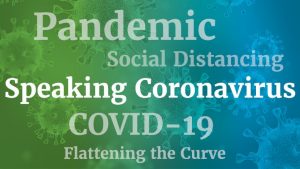Define key terminology used in this course:
-
- Review the terms listed in the terminology section
- Spell the listed terms accurately
- Pronounce the terms correctly
- Use the terms in their proper context
- CDC – Centers for Disease Control and Prevention
- WHO – World Health Organization
- Virus – A tiny, nonliving particle that invades and then reproduces inside a living cell.
- Coronavirus/COVID-19 -Coronaviruses (CoV) are a large family of viruses that cause illnesses ranging from the common cold to more severe diseases such as Middle East Respiratory Syndrome (MERS-CoV) and Severe Acute Respiratory Syndrome (SARS-CoV).
- Pneumonia -Inflammation of the lungs
- Global -(adj.) of, relating to or involving the entire world; comprehensive
- Pandemic – and epidemic that is geographically widespread
- Infection – Contamination or invasion of body tissue by pathogenic organisms
- Outbreak – A sudden rise in the incidence of a disease
- Symptoms – the conditions that together tell a doctor what is wrong
- Migration – the movement of people from one place to another
- Essential – absolutely necessary
- Antibodies An antibody is a blood protein that the immune system makes as a response to an invader (pathogen), such as a virus.
- Containment strategies are used at the beginning of an outbreak.
- Flattening the curve When viewed on a graph, a sudden surge in people getting sick with COVID-19 over a very short period (within a few days) can look like a tall, narrow curve, similar to a spike
- Immunocompromised People who are immunocompromised have a weakened immune system, meaning their white-blood-cell counts are low or they have other conditions that make it harder to fight off infections and diseases.
- Incubation The period between when a person is first exposed to a virus and when they develop symptoms is known as the incubation period. Knowing the incubation period for the coronavirus can help experts know when the disease can be spread, even if a person is without symptoms.

- Intubation This is a medical procedure that may be used for people with severe COVID-19 who are unable to breathe on their own. A flexible plastic tube (a breathing tube) is inserted through the mouth into the trachea, the large airway from the mouth to the lungs. The tube is then connected to a machine called a ventilator that can move air to and from the lungs.
- Isolation If a person has a confirmed case of coronavirus, they are instructed to practice isolation, which may be at home or in the hospital, depending on how sick the person is. It’s meant to keep sick people from infecting other people by keeping them away from everyone.
- Physical distancing, commonly referred to as social distancing, is the deliberate increase of physical space between people to keep them from spreading illness
- Personal protective equipment or PPE is equipment worn by healthcare workers to reduce exposure to the coronavirus. The CDC recommends that those caring for people to keep them from spreading illness personal protective equipment or PPE is equipment worn by healthcare workers to reduce exposure to the coronavirus.
- Respirator – with COVID-19 wear goggles or a disposable full-face shield, a respirator known as an N95 mask, a gown that covers their clothes, and clean gloves.
